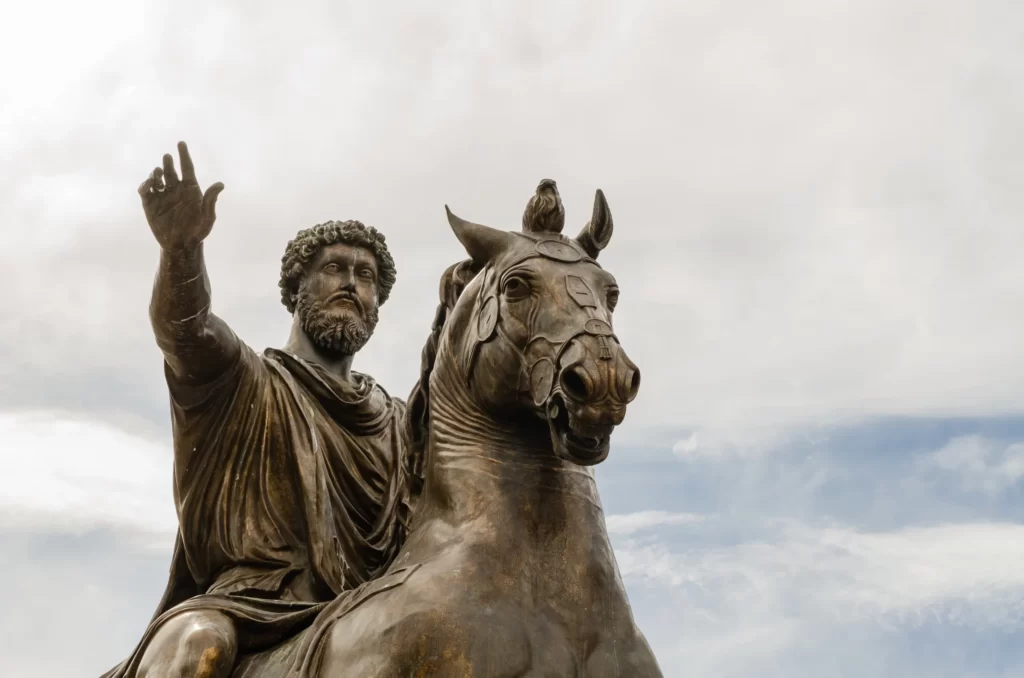Stoicism

A practical interpretation of life thanks to Stoicism
Learning to control thoughts is something that humanity has struggled with for centuries. Everyone is used to their own thought pattern that they have created through events, parents, childhood, etc. But these thoughts are not always helpful. In fact, people sometimes tend to worry about things they have no control over at all.
There are countless beliefs, philosophies and beliefs around the world. But only a few of them are actually practically furnished. That means, in the here-and-now helps people with their problems. Stoicism is a wonderful example of this. It mainly supports people with questions such as: “What is important in life?” and “How do I get through this difficult period?”
Zeno van Citium is the original founder of Stoicism, which has evolved over the centuries into the Stoicism of modern times. It was one of the most important philosophical movements in the Roman Empire. It has influenced many people, for example the emperor Marcus Aurelius, but in recent centuries there have also been great figures who used Stoicism. People such as Theodore Roosevelt and Friedrich Nietzsche are also known for their practical thinking, which is derived from the philosophical school.
A well-known slogan used by many Stoics is – Memento mori – remember to die[HYPERLINK FROM MEMENTO TO THE BLOG]. This may sound like a depressing thought, to think of death, but it is absolutely not meant to be. The main thing is that people start living the life that makes them happy. And then today. Not tomorrow, not in a year or two. No, today.
Stoic has a negative meaning in the Netherlands
In the Netherlands, the meaning of the word ‘stoic’ has unfortunately acquired a mostly negative meaning. Often the word is used for someone who acts dispassionately or is unable to accept other people’s feelings. They seem like people without emotions or fluctuations.
And that while stoicism is not really structured like that at all. It is not that the stoics suppress or avoid the emotions, but rather master them. Emotions and expressing them are also normal for them.
The core values of stoicism are actually quite simple and practical. The world is unpredictable, changes are constantly lurking and our human life is relatively short. In addition, our existence, in a relative sense, has little influence on the future of the world. That makes it difficult to really get a grip or control over life.
This can especially cause dissatisfaction with life. Unhappy and ignorant of what you actually want to achieve and what makes you happy. Often we focus on things that we have no influence on. Think of the rude actions of strangers in traffic, or perhaps even bigger things such as the fact that we cannot influence the weather. But we have a body and a brain, with which we can exert a lot of influence internally, in order to get a little more grip on life and our feelings.
The main figures in Stoicism
Over the centuries, Stoicism has become, in a way, more and more practical. It all started with Zeno van Citium, but has often been added by important figures in history, from all over the world. Stoicism can be divided into three or even four periods.
The Old Stoa
We know the ancient Stoa, Stoicism from ancient Greece with the three most famous Stoics: Zeno of Citium, Chrysippus and Cleanthes. Zeno is the original founder of Stoic philosophy, and taught in the famous Agora of Athens. It is also named after this. A ‘stoa’ literally means: Covered colonnade.
Unfortunately, very few texts have survived from this time. We do have fragments that allow us to draw the broad outlines, but there is no complete work present, which makes it difficult to provide more precise information. It is well known to us that at that time a lot of attention was also paid to physics, mathematics and logic. This is in contrast to the Middle Stoa and the Younger Stoa, in which these subjects were treated less.
The Middle Stoa, Stoicism in Rome
The Ancient stoa soon found its way into the Roman Empire. In ancient Stoa, people believed that the world repeats itself over and over again, a circular time. Think of the birth of the earth, the destruction of life on earth, the lives of man. Everything would repeat itself continuously. This line of thought was slowly but surely repelled.
The most famous and influential Stoic of this time was Panaetius. His presence in Rome fueled Stoicism and, with the help of other philosophers, it was not long before Stoicism became known in the Roman Empire.

The Young Stoa
The Young Stoa is the stoicism that flourished in Roman times. In this, the focus is mainly on philosophy of life, and less on pursuits such as logic, physics and other such concepts. Centrally focused on people, with problems such as “How do we deal with setbacks?” “What does a good life mean to me?” or “How do I become happy?”
This Stoa is the one that people talk about the most and is still used to this day.
There are a number of important philosophers of the Roman era, whose full texts we also have at our disposal. We start with one of the most prominent Stoics who was even one of the educators and later advisers of Emperor Nero.
Seneca – Seneca was known for spewing progressive thoughts and was not afraid to learn from other philosophies or beliefs. He was fiercely against unnecessary violence such as gladiator fights, but also frequently spoke out against slavery. Finally, at the age of 65, he was forced to commit suicide by Nero, as he was suspected of treason.
Marcus Aurelius (the Emperor-Philosopher) – A former emperor of the Roman Empire. At the time, this was the most powerful man on earth and he followed the philosophical trend of Stoicism. He followed the practical train of thought and learned a lot about how best to behave yourself, what to focus on and what not to pay attention to because it is grossly useless in the bigger picture.
Epictetus – He was born into a slave and got permission from his master to study Stoicism, something that got him through all those years of slavery. After years of good behavior, he was rewarded with his freedom. He then founded his own school to spread the philosophy and established himself as one of the founders of Stoicism as we know it today.
With all these examples, we can clearly state that stoicism provides a strong factor for people in a difficult position. Epictetus might never have made it this far without the supporting thoughts of Stoicism. In addition to these examples, there have been plenty of great figures throughout the ages who have practiced some form of stoicism to clarify their responsibilities. Think of Theodore Roosevelt, Frederick the Great and even people like Bill Clinton have indicated that they learn from the extensive philosophy.
Today, stoicism is flourishing again. There is even talk of a revival in which the old way of thinking of philosophy of life is incorporated into an appropriate line of thought that can also be useful in the modern environment in which we live. Especially in the online world we see more and more blogs and websites focused on stoicism.
What is in our control, and what is not? In modern times this is somewhat simplified. It mainly looks at how we can keep our emotions in check and how we can suppress our desires in a healthy way, while still enjoying life a little. Think of continuously having the need to eat delicious fries, but limiting yourself to once a week for your health.
This new modern form of stoicism is also called De Nieuwe-Stoa. With the aim of reaching a wider audience, the old philosophy of life has remained basically the same in thought, but changes in terms of context and background.
Is stoicism for you?
Now the question remains: Is this philosophical movement for you? That is always difficult to say. Anyone can take positive factors from a more practical mindset. In addition, it can bring a lot of personal power, as we have seen with the former slave Epictetus.
Could you use a little more structure in your daily life? Perhaps a little more control over your own emotions and the things you do have control over? Then maybe it’s time to use small factors of stoicism. Not sure where to start? Look at these handy Memento Mori calendars to make it a little easier for yourself.
